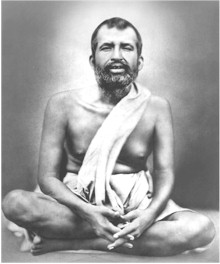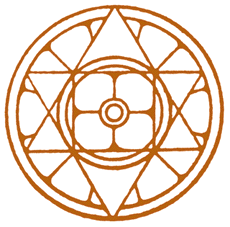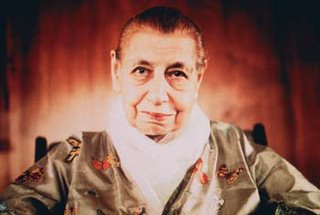 Swami Vivekanandha
Swami Vivekanandha
Do you known how much energy, how many powers, how many forces are still lurking behind that frame of yours? What scientist has known all that is in man? Millions of years have passed since man first came here, and yet but one infinitesimal part of his powers has been manifested. Therefore, you must not say that you are weak. How do you know what possibilities lie behind that degradation on the surface? You know but little of that which is within you. For behind you is the ocean of infinite power and blessedness.
Men are taught from childhood that they are weak and sinners. Teach them that they are glorious children of immortality, even those who are the weakest in manifestation. Let positive, strong, helpful thought enter into their brains from the very childhood. Lay yourselves open to these thoughts, and not to weakening and paralyzing ones. Say to your own minds, "I am He [pure, free, immortal spirit]," "I am He [pure, free, immortal spirit]."
What makes a man stand up and work? Strength. Strength is goodness; weakness is sin. If there is one word that you find coming out like a bomb from the Upanishads, bursting like a bombshell upon masses of ignorance, it is the word fearlessness. And the only religion that ought to be taught is the religion of fearlessness. Either in this world or in the world of religion, it is true that fear is the sure cause of degradation and sin. It is fear that brings evil. And what causes fear? Ignorance of our own nature.
Weakness leads to all kinds of misery, physical and mental. Weakness is death. There are hundreds of thousands of microbes surrounding us, but they cannot harm us unless we become weak, until the body is ready and predisposed to receive them. There may be a million microbes of misery, floating about us. Never mind! They dare not approach us; they have no power to get a hold on us, until the mind is weakened. This is the great fact; strength is life; weakness is death; strength is felicity, life eternal, immortal; weakness is constant strain and misery; weakness is death.
We reap what we sow. We are makers of our own fate. None else has the blame, none has the praise.
Religion is the greatest motive power for realizing that infinite energy which is the birthright and nature of every man. In building up character, in making for everything that is good and great, in bringing peace to others, and peace to one's own self, religion is the highest motive power, and therefore, ought to be studied from that standpoint. Religion must be studied on a broader basis than formerly. ...
As the human mind broadens, its spiritual steps broaden too. The time has already come when a man cannot record a thought without its reaching to all corners of the earth; by merely physical means, we have come into touch with the whole world; so the future religions of the world have to become as universal, as wide.
The religious ideals of the future must embrace all that exists in the world and is good and great, and, at the same time, have infinite scope for future development. ...
The power of religion, broadened and purified, is going to penetrate every part of human life. So long as religion was in the hands of a chosen few, or of a body of priests, it was in temples, churches, books, dogmas, ceremonials, forms and rituals. But when we come to the real, spiritual, universal concept, then, and then alone, religion will become real and living; it will come into our very nature, live in our every movement, penetrate every pore of our society, and be infinitely more a power for good than it has ever been before.
Aye, let every man and woman and child, without respect of caste or birth, weakness or strength, hear and learn that behind the strong and the weak, behind the high and the low, behind every one, there is that Infinite Soul, insuring the infinite possibility and the infinite capacity of all to become great and good. Let us proclaim to every soul “Arise, awake and stop not till the goal is reached."
Teach yourselves, teach everyone his real nature, call upon the sleeping soul and see how it awakes. Power will come, glory will come, goodness will come, purity will come, and everything that is excellent will come when this sleeping soul is roused to self-conscious activity.
The infinite power of the Spirit, brought to bear upon matter evolves material development, made to act upon thought evolves intellectuality, and made to act upon Itself makes of man a God. ... Manifest the divinity within you, and everything will be harmoniously arranged around it.
Our watchword, then, will be acceptance, and not exclusion. Not only toleration, for so-called toleration is often blasphemy, and I do not believe in it. I believe in acceptance. Why should I tolerate? Toleration means that I think that you are wrong and I am just allowing you to live. Is it not a blasphemy to think that you and I are allowing others to live? I accept all religions that were in the past, and worship with them all; I worship God with every one of them, in whatever form they worship Him. ...
The Bible, the Vedas, the Koran, and all other sacred books are but so many pages, and an infinite number of pages remain yet to be unfolded. I would leave it open for all of them. We stand in the present, but open ourselves to the infinite future. We take in all that has been in the past, enjoy the light of the present, and open every window of the heart for all that will come in the future. Salutation to all the prophets of the past, to all the great ones of the present, and to all that are to come in the future.
One atom in this universe cannot move without dragging the whole world along with it. There cannot be any progress without the whole world following in the wake, and it is becoming every day clearer that the solution of any problem can never be attained on racial, or national, or narrow grounds. Every idea has to become broad till it covers the whole of this world, every aspiration must go on increasing till it has engulfed the whole of humanity, nay, the whole of life, within its scope.
The infinite oneness of the Soul is the eternal sanction of all morality, that you and I are not only brothers --every literature voicing man's struggle towards freedom has preached that for you --but that you and I are really one. This is the dictate of Indian philosophy. This oneness is the rationale of all ethics and all spirituality.
We want today that bright sun of intellectuality, joined with the heart of Buddha, the wonderful, infinite heart of love and mercy. This union will give us the highest philosophy. Science and religion will meet and shake hands. Poetry and philosophy will become friends. This will be the religion of the future, and if we can work it out, we may be sure that it will be for all times and peoples.
Just as a physicist, when he has pushed his knowledge to its limits, finds it melting away into metaphysics, so a metaphysician will find what he calls mind and matter are but apparent distinctions, the reality being One.
The more advanced a society or nation is in spirituality, the more is that society or nation civilized. No nation can be said to have become civilized, only because it has succeeded in increasing the comforts of material life by bringing into use lots of machinery and things of that sort. ... In this age as on the one hand people have to be intensely practical, so on the other they have to acquire deep spiritual knowledge.
No civilization can grow, unless fanaticism, bloodshed, and brutality stop. No civilization can begin to lift up its head until we look charitably upon one another, and the first step towards that much-needed charity is to look charitably and kindly upon the religious convictions of others. Nay more, to understand that not only should we be charitable, but positively helpful, to each other, however different our religious ideas and convictions may be.
Look upon every man, woman, and everyone as God. You cannot help anyone; you can only serve; serve the children of the Lord, serve the Lord Himself, if you have the privilege. If the Lord grants that you can help anyone of His Children, blessed you are; do not think too much of yourselves. Blessed you are that that privilege was given to you, when others had it not. Do it only as a worship.
You may invent an image through which to worship God, but a better image already exists, the living man. You may build a temple in which to worship God, and that may be good, but a better one, a much higher one, already exists, the human body.
We have always heard it preached, "Love one another." What for? That doctrine was preached, but the explanation is here. Why should I love everyone? Because they and I are one. Why should I love my brother? Because he and I are one. There is this oneness, this solidarity of the whole universe. From the lowest worm that crawls under our feet to the highest beings that ever lived --all have various bodies, but are the one Soul. Through all mouths you eat; through all hands you work; through all eyes you see. You enjoy health in millions of bodies, you are suffering from disease in millions of bodies. When this idea comes and we realize it, see it, feel it, then will misery cease, and fear with it. How can I die? There is nothing beyond me. Fear ceases, and then alone come perfect happiness and perfect love. That universal sympathy, universal love, universal bliss that never changes, raises man above everything.
We have to cover everything with the Lord Himself, not by a false sort of optimism, not by blinding our eyes to the evil, but by really seeing God in everything. Thus we have to give up the world, and when the world is given up, what remains? God. What is meant? You can have your wife; it does not mean that you are to abandon her, but you are to see God in the wife. Give up your children; what does that mean? To turn them out-of-doors as some human brutes do in every country? Certainly not. That is diabolism; it is not religion. But see God in your children. So, in everything. In life and in death, in happiness and in misery, the Lord is equally present. The whole world is full of the Lord. Open your eyes and see Him. This is what Vedanta teaches.
India has to learn from Europe the conquest of external nature, and Europe has to learn from India the conquest of internal nature. Then there will be neither Hindus [Indians] nor Europeans --there will be the ideal humanity which has conquered both the natures, the external and the internal. We have developed one phase of humanity, and they another. It is the union of the two that is wanted. The word freedom which is the watchword of our religion means freedom physically, mentally, and spiritually.
It is a change of the soul itself for the better I that alone will cure the evils of life. No amount of force, or government, or legislative cruelty will change the conditions of a race, but it is spiritual
culture and ethical culture alone that can change wrong racial tendencies for the better.
But the basis of all systems, social or political, rests upon the goodness of men. No nation is great or good because Parliament enacts this or that, but because its men are great and good. ... Religion goes to the root of the matter. If it is right, all is right.
Great indeed are the manifestations of muscular power, and marvelous the manifestations of intellect expressing themselves through machines by the appliances of science; yet, none of these are more potent than the influence which spirit exerts upon the world.
I direct my attention to the individual, to make him strong, to teach him that he himself is divine, and I call upon men to make themselves conscious of this divinity within. That is really the ideal --conscious or unconscious --of every religion.
It is a man-making religion that we want. It is man-making theories that we want. It is man-making education all round that we want. And here is the test of truth --anything that makes you weak physically, intellectually, and spiritually, reject as poison, there is no life in it, it cannot be true. Truth is strengthening. Truth is purity, truth is all knowledge; truth must be strengthening, must be enlightening, must be invigorating.
The Christian is not to become a Hindu or a Buddhist, nor a Hindu or a Buddhist to become a Christian. But each must assimilate the spirit of the others and yet preserve the individuality and grow according to his own law of growth.
If the Parliament of Religions has shown anything to the world it is this: It has proved to the world that holiness, purity, and charity are not the exclusive possessions of any church in the world and that every system has produced men and women of the most exalted
character. In the face of this evidence, if anybody dreams of the exclusive survival of his own religion and the destruction of the others, I pity him from the bottom of my heart, and point out to him that upon the banner of every religion will soon be written, in spite of their resistance: "Help and not Fight," "Assimilation and not Destruction," "Harmony and Peace and not Dissension."









